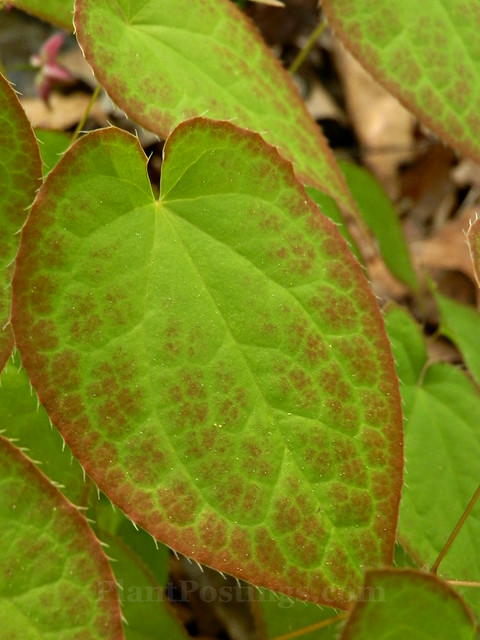
Do you prize Epimediums more for their foliage or for their blooms?
For me, it depends--based on the season, the siting, and the species or hybrid.

Many years ago, Epimediums jumped to the top of my "wish" list: because they're distinctive ground-cover plants, they thrive in dry shade, they have attractive foliage, and (supposedly) they're deer- and rabbit-resistant (more on that later).
I held off for a long time because I've tried to add more native plants to my garden. (Epimedium species are native to Asia and the Mediterranean).
A few years ago, I couldn't resist. I decided to add two Epimediums to a garden plot near the house that features mostly non-native, rabbit-resistant and rabbit-repellent plants. This is a contained area, surrounded by sidewalks and a rock wall: The plants won't bolt. In 2014, I added a third Epimedium.
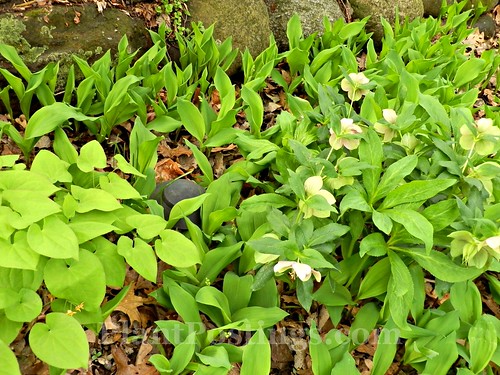 |
| Epimedium x warleyense on left, Helleborus orientalis on right; mixed with Convallaria majalis. |
It's a mild microclimate anchored by that rock wall. Neighboring plants include Hellebores and Convallarias (Lily-of-the-Valley), among others. The entire area is probably more like a windless USDA zone 6, and the temperatures are more constant and mild than the rest of my garden. The Epimediums are happy here.
The first two survived the polar vortex of 2013-2014, and the third survived last year's brutal February. The Brooklyn Botanic Garden notes that most Epimediums are hardy to zone 5. (You can learn more about Epimediums, in general, by visiting the link.) I love the nicknames of these plants: Barrenwort, Bishop's Hat, Fairy Wings, Horny Goat Weed, Rowdy Lamb Herb ... and others.
So, back to my original question: foliage or blooms? Well, here's my take, based on my limited experience with the three cultivars in my garden:
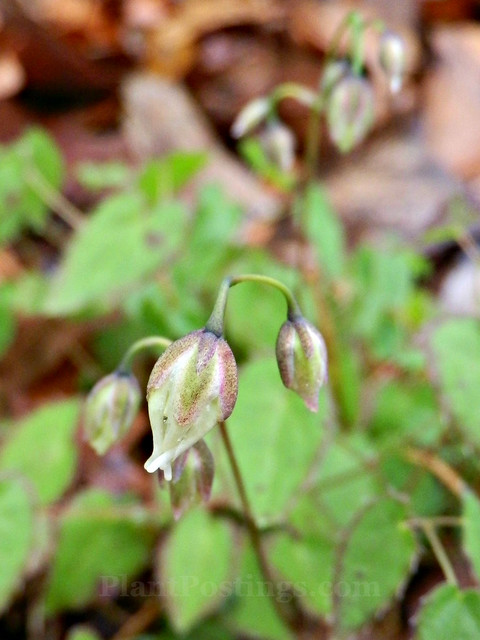 |
| E. grandiflorum 'Creeping Yellow' |
One of my first purchases was 'Creeping Yellow.' I'm not sure why "yellow" is in the name. Neither the blooms nor the foliage are particularly yellow.

The buds on this one are luscious, and at a certain point, the flower spurs crisscross in a delightful dance.
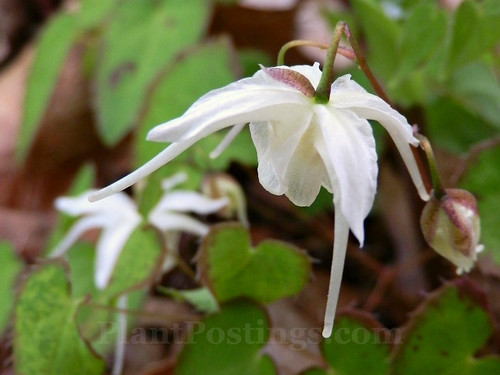
The blooms are ethereal and do, indeed, resemble fairy wings.
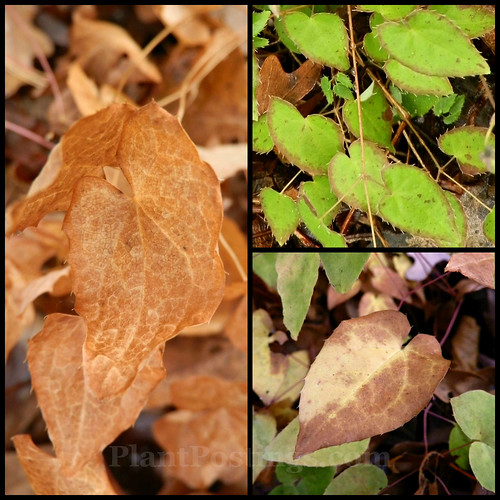 |
| 'Creeping Yellow' foliage, clockwise from top right: spring, autumn, late autumn. |
Some sources suggest this plant is hardy to zone 4, but in my garden--even in that microclimate location--this is the only Epimedium of the three that is not evergreen.
The foliage is tiny. Leaves begin a beautiful bright green with russet edges. During the summer, the edges blend to green; in the fall the leaves have an attractive speckled appearance; and by late fall the entire leaf surface forms a coppery color and falls off. This plant goes entirely dormant in my garden, and new growth appears as tiny new shoots in the early spring.
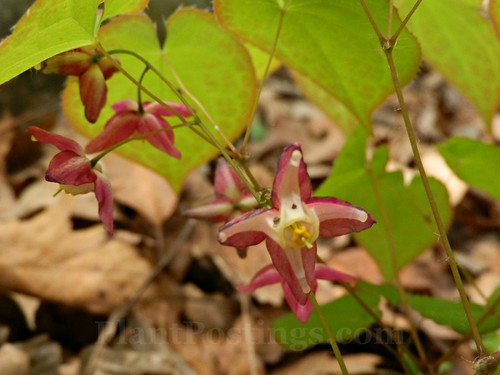 |
| E. x rubrum |
E. x rubrum is my most recent purchase. Its flowers are a little more complex in color, but with shorter spurs.
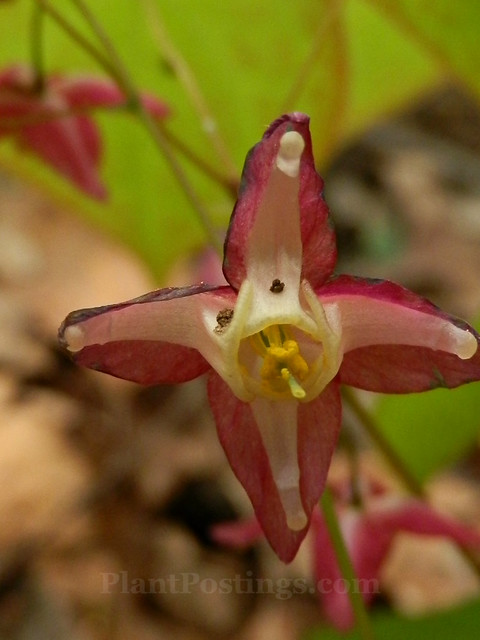
Like the other Epimediums, rubrum's blooms form under the foliage and arc downward, so you need to peer closely to see them ... certainly worth the effort.
 |
| Rubrum foliage, clockwise from left: spring, summer, fall. |
Rubrum has more distinctive foliage during the spring and fall, and it seems to stay semi-evergreen through the winter. I find it interesting that the red color fades in summer and then reappears in the veins of the foliage in autumn.
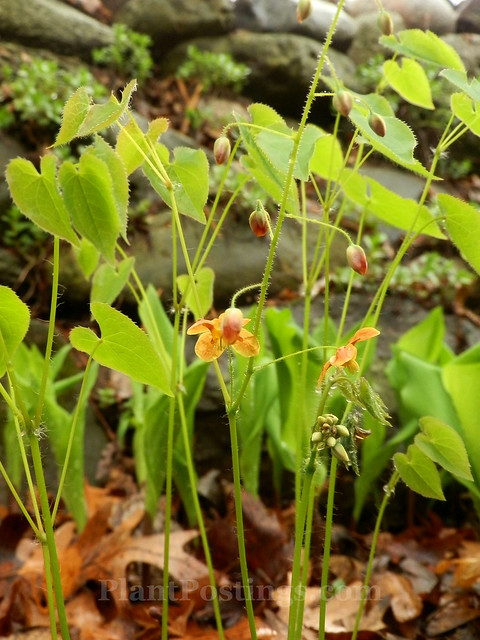 |
| E. x warleyense |
Finally, E. x warleyense is a taller hybrid, with more prominent orange buds and flowers that shoot up through the foliage.
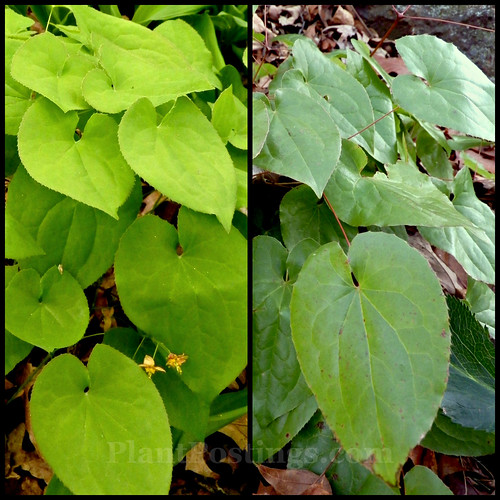 |
| Warleyense foliage: spring on left, late autumn on right. |
Warleyense foliage remains green throughout the year--starting bright chartreuse green and darkening to a deep green with a shiny surface. When the snow melts, the leaves remain in late winter/early spring.
This plant is by far the healthiest Epimedium in my garden and I've already divided it and planted it in another spot. Interestingly, rabbits haven't touched warleyense in its original location, but they entirely consumed the leaves off the transplant!
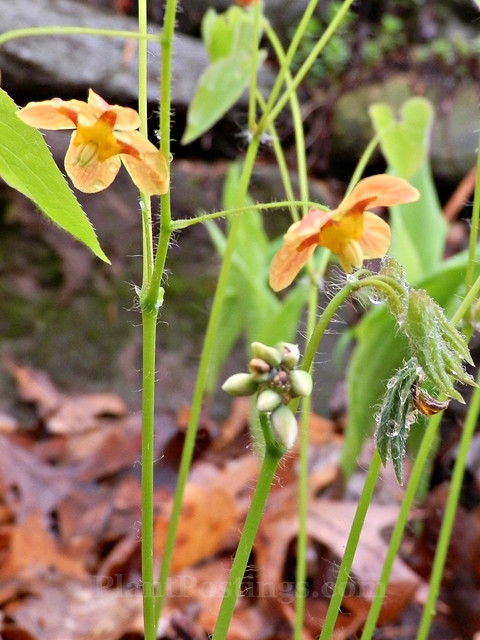
Not to worry: New buds, flowers, and foliage will emerge in the spring, and I'll clip off the old foliage anyway.

The blooms of this one are my delight!
One thing to keep in mind if you're new to Epimediums: The blooms and stems are tiny and the plants seem fragile, but they're much sturdier than they appear.
How about you? Do you grow Epimediums? Which species and hybrids are your favorites, and why?
Since my garden is currently dormant, it's probably inappropriate to link to Garden Bloggers Bloom Day at May Dreams Gardens and Foliage Follow-Up at Digging, but I add their links here. Check them out on the 15th and 16th: It's a great way to beat the winter doldrums!
new to me, and such beautiful delicate flowers!
ReplyDeleteI noticed they were very common in London when we visited there, and many of our U.S. botanical gardens have Epimediums. They are lovely and they help solve the challenges of deep shade and dry shade.
DeleteI had not heard of them.. Now I know.. Thank you
ReplyDeleteYou are welcome. They are early bloomers, so they aid the spring pollinators. Plus, they're attractive mounding ground covers.
DeleteI knew very little about Epimediums until I read your posting, Beth. Excellent information. I think I will give them a try. I assume they can take shade as you grow them with hellebores? I would like them for groundcover in my Woodland Walk. I prefer natives, too, but I'm not a purist. P. x
ReplyDeleteYes, they prefer shade--either dappled or deep shade. The one the rabbit ate is in a sunnier area and doesn't appear to be doing as well (even before the rabbit ravished it). My understanding is that Epimediums can be a little invasive--but maybe that's more of a problem in a warmer climate. I haven't found them to be so.
DeleteHaven't grown them but I know they're well regarded. The rubrum's flower is lovely in color as is Warleyense.
ReplyDeleteYes, I know many folks have great collections of them. I'm pleased to have tried three. I actually like all the flowers, but prefer the foliage of the rubrum and the flowers of the other two.
DeleteBeautiful foliage and its flower too. Thank for sharing this new plant!
ReplyDeleteYou are welcome, Endah. They are fun little plants, and especially good players in a rock garden. :)
DeleteI have a really large patch of epimediums that I transplanted from another spot. They reseed for me. I had so many I gave huge chunks away to a neighbor with lots of dry shade, too. They're one of my favorite dry shade plants. :o)
ReplyDeleteNice! I imagine they would be very happy in your lovely garden, Tammy. I'm a little obsessed with them lately. They're nearly as fascinating as Hellebores, although I thing the Hellebores will always be my favorite prized shade perennial plants.
DeleteI probably have about ten named varities. Only had rabbit problems once or twice with new plants. I caged them for the first couple of years. Rubrum and Lilac Fairy ate the most prolific. I consider them as groundcovers. I treat most of the other ones as specimen plants . I have never lost any due to weather.
ReplyDeleteNice! I noticed that the rabbits didn't touch the new transplant until late fall, so maybe the food sources were getting scarce by then. Lately, I've noticed their eating my Lilacs and Hydrangeas, which, unfortunately is common in midwinter. I'll have to research 'Lilac Fairy.' :)
DeleteNice post on Epimediums! I have 'Rubrum' and a yellow variety (I forget the name right now) and you are right, they are pretty hardy and carefree. I love your latest addition. Very showy.
ReplyDeleteAs always, I want to thank you for all your thoughtful comments on my blog. You are so wonderful about leaving them. About calibrating your monitor ~ it's suggested to do from time to time to make sure the colors are being seen as true in print as they are on your monitor. For example have you ever thought one of your photos was really great (either before or after editing) only to print it out & have it be too dark or too much of one color? That's basically the test. Think of it as white balancing the monitor like you do with your camera. I'm no expert, still trying to learn and improve my photos and since I do print them, it's another thing to consider. So long answer to your question, wouldn't adjusting the photo editing do the same ~ not really. On screen perhaps but if your monitor is off, it wouldn't print as well. Hope I sort of explained that?? I see a difference in the photos on screen too tho??
Happy New Year too!!!!
Hi Kathleen: I'm amazed at all the beautiful varieties. Thank you, too, for visiting here and sharing your information and impressions. Thanks for the explanation. I've very rarely re-calibrated my monitor, and I don't edit my photos much beyond cropping and occasional other minor adjustments. The light conditions can make such a difference in the tint and the exposure of the photo. Sometimes I'm amazed that two photos were taken of the same object at slightly different times!
DeleteI love this plant. Every aspect is a plus in my experience. Leaves or blooms it is a garden worthy plant.
ReplyDeleteYes, I'm finding that, too, Lisa. For some the foliage is more fascinating and for others the flowers are more distinct. The season makes a difference, too. But I like all of them!
DeleteI have one named variety 'Irene' that did well until last year's awful winter... perhaps it will reappear next spring. Epimedium rubrum and sulphureum are hardy for me in rural Quebec, not far north of the Vermont border, and I love how they have spread. I could divide them but am leaving them to form a large mass.
ReplyDeleteHi Pat: I'll have to check out 'Irene' and sulphureum. I'm amazed at how many varieties are available. In my garden, the only one that has been large enough to divide so far is warleyense. The others haven't spread much at all.
DeleteDespite hearing that epimediums do well in dry shade I have lost a few to that direct cause. I still have one alive in deep shade that does well although it has not grown much in the 8 years I have been growing it. Like you I grow primarily natives and two years ago I finally gave in to my lust of Brunnera 'Jack Frost'. What a delight it has been in shade sitting next to a native dicentra!
ReplyDeleteI know many people around here like to grow Brunnera, too. I don't have it, but it is a beautiful plant. My Epimediums are in dappled shade and near the house, so easy access for watering during drought. Last summer, however, we had ample rain so there was no need to supplement. Good to know they might struggle in deep, dry shade.
DeleteI too have been in the native plant arena when it comes to new plantings. However, I am a plant geek, and I am always searching for shade tolerant species. I may try some of these in the future.
ReplyDeleteThat pretty much sums it up for me, too. To have a garden in this mixed up, unbalanced suburban ecosystem, I need plants that are shade-tolerant and rabbit-resistant. For the most part, Epimediums seem to fit those requirements.
DeleteTotally new to me, but the little flowers look very nice! Added to the list for the future! Thanks
ReplyDeleteI'm surprised, Lula. I would have thought you'd be familiar with the Mediterranean species. Yes, I recommend them. You will like them. :)
DeleteEpimedium x perralchicum 'Frohnleiten' has done very well for me in Tennessee. It has spread steadily and makes a gorgeous evergreen / semi-evergreen groundcover, but has not reseeded. (I'm a bit jealous of Tammy's volunteer Epimedium seedlings!)
ReplyDeleteI just planted x warleyense and x versicolor 'Sulphureum'. I have high hopes for both of them!
Generally, I'd say I grow Epimediums mainly for their foliage, although the flowers are a nice bonus.
I wish they were more popular... I think the tongue-twisting names are a problem for some people. And they do take a little while to get established, which can be challenging for people who want instant gratification. But I think Epimediums are a perfect illustration of the saying, "Good things come to those who wait!" :)
That's so interesting that you say it takes some time for them to become established. The ones I've planted settled in nicely in the first season and have come back readily since. Pat mentioned sulphurium, too, and I checked it out. I like it! Reminds me of rubrum but with a flower I like better! I think some of the varieties are sterile, so maybe those are the ones you have? So, while they'll spread by rhyzomes over time, they won't re-seed. I'll have to check out 'Frohnleiten.'
DeleteYour post inspire me to grow some. I used to have one in my previous garden but it was not doing well. I realize now I was asking too much of the poor thing.
ReplyDeleteI'll be curious to see which cultivar(s) you select, Alain. I'm debating whether I might add just one more variety ...
DeleteI have one, although I only knew it by the name "barrenwort". When we built an addition on our house, and my hips were still the old arthritic ones, I had a friend who working in landscape. She chose plants for around the foundation of the new addition, and she planted what I'm pretty sure is "sulphureum" at the base of a Korean spice bush. It's also in a dry shade area, and near the house. It is one of my very favorite plants, and I have to admit I love it for the flowers. They are tiny, delicate, and yellow. I had never looked for other varieties, but based on your photos, I think I'm going to find some more for an adjacent area!
ReplyDeleteHi Cassi: I didn't realize you'd had hip surgery. Others have mentioned sulphureum, too. I like it! In fact, I think I like it better than rubrum for its flowers (they seem to have similar foliage). I'll be curious to hear which other varieties you select.
DeleteNice plant group, but I do not grow them in my garden. Really, I don't have much shade. Many pretty varieties though.
ReplyDeleteI envy you your sunlight, Donna. I have limited sunny spots in my garden.
DeleteI adore epimediums, foliage and flowers. My problem is pheasants. They strip all the flowers off as soon as they open.
ReplyDeleteGosh, I never guessed avian visitors would go for the flowers! We sometimes have wild turkeys here. I wonder if they would be a potential threat, too.
DeleteCan you believe I don't have any in my garden?! I have lots of dry shade, you've convinced me I need to add them to this area. Thanks for the link to learn more.
ReplyDeleteHi Karin: I didn't have them for ages, either, as I described. The more I think about it, the more I'm tempted to try them in pots. I wonder if that would be a good option for you, too?
DeleteI've been keeping my eye out for shade loving plants for the borders of the hilltop area, which is a shady, wooded area. I'll not be tackling that section for a while, but planning always starts long before doing ;) How interesting that the rabbits didn't get to those plants in the first area but munched those in the 2nd area - would this mean that your rabbit deterrent plants are working?
ReplyDeleteYes, I think the rabbit-deterrents are part of the answer, Margaret. Also, the rabbits only seemed interested in the plants in late autumn/early winter--likely because the food sources were dwindling. I'm hoping they won't chew on the new growth this spring. I guess I'll have to watch the plants and maybe cage them until they're established.
DeleteWhen I first started my garden I found epimediums....and was hooked or should I say I was addicted and bought several...I have no idea which ones they are but hope to identify them....one I do know by flower and foliage is E. x rubrum which I adore. And I can't say which I love better...foliage of flower....both are so enticing!
ReplyDeleteHi Donna: I agree regarding the foliage and flowers, although it varies depending on the cultivar for me. They are all so unique. How lucky you were to inherit some Epimediums.
DeleteAt first I was not crazy about Epimediums, but they have grown on me. I like them most for the foliage. They can be a very tough and reliable ground cover in dryish shade.
ReplyDeleteI've been fascinated with them from the moment I first saw them. And finally I decided it was time. Yes, they do appear to be reliable and great plants for shade.
DeleteHi Beth, I think the foliage AND the blooms are lovely on Epimediums, so why not grow them for both? I have seen some spectacular beautiful cultivars on some of the English blogs.
ReplyDeleteIn my garden I don't grow any and I don't recall seeing them in local nurseries. Maybe they are not suited for Southern California. But your post inspired me to do some research and find out, if it would be possible to grow them in my area as well.
Warm regards,
Christina
I do too, although I prefer different aspects of different hybrids. For example, I prefer the foliage of rubrum, but the flowers of warleyense. They are all wonderful, however. I think they must be very happy in a temperate woodland. That's where I've seen them the most. Good luck! I'll be curious to learn if people grow them in Calif. woodlands.
DeleteI have in my garden E. x rubrum and beautifully me grow. I like and the flowers and leaves. Regards.
ReplyDeleteIt seems our climates are somewhat similar--especially in winter. I imagine these plants would be very happy in your garden, Giga!
DeleteI like both the flowers and foliage of epimediums. I grow several different types. I always cut the foliage back before the new flowers emerge, so I can enjoy the tiny blossoms before the foliage takes over. In my garden it takes a couple of years before a newly planted epimedium becomes established, but it is very easy-care and reliable after that.
ReplyDeleteI think I remember you highlighting them on your blog, Deb. I cut back the old foliage in the spring, too. In fact, they follow a similar schedule and maintenance routine as my Hellebores, which grow in the same garden area. It's so exciting to see the new growth each spring. I've found them to be easy care, too.
DeleteYou have a lovely collection of epimediums. I love them too, both for the pretty leaves and the dainty flowers. Like Deb I cut the foliage off when the buds appear so that I can enjoy the flowers.
ReplyDeleteThanks, Chloris. It's been fun getting to know them in my own garden during the past few years, after admiring them in other gardens for so long. I cut back the old foliage in the spring, too.
DeleteI just added several epimediums to the garden last fall that I found on deep clearance at the nursery. I've never grown them before, but I find the foliage so pretty. They all lost their leaves (what little leaves a couple of them had) for winter, including the warleyense, so we'll see if the little discount plants survive the winter! I'm hoping!
ReplyDeleteOh fun! It will be fun to see them emerge in the spring. They're magical to watch--they start out so small and delicate-looking and grow into sizable mounds of lovely foliage.
DeleteI love Epimediums because they are so delicate looking. I have only grown them in pots so far though as I worry about 'losing' them if I planted them in a border. You have some absolute beauties!
ReplyDeleteI agree: They look so much more delicate than they are. I like the idea of growing them in pots--I'll have to try that, too. :)
DeleteI also love epimediums, though I did not know there were so many varieties. Yours are gorgeous!
ReplyDeleteI suppose a person could get carried away collecting them. I'll have to be careful so that doesn't happen to me. ;-)
DeleteI just discovered epimediums a few years ago and only have two in my garden, but I suspect I will be adding many more over the next few years. I do love their tiny blooms, which force me to stop and look more closely at the garden. But it's really the foliage I enjoy since the blooms don't last long.
ReplyDeleteHi Rose: Yes, the blooms are really magical--like the fairy wings in one of their nicknames. It's too bad they don't last longer, but I guess the foliage is what makes them especially desirable in the garden. :)
DeleteI love epimediums, both leaves and flowers, and do collect them. I have about 40 varieties but there are hundreds. Garden Vision Epimediums is the mail order source to go to, excellent plants and a catalogue that is more like a reference book. I have never heard of 'Creeping Yellow'. Your photo looks like 'Niveum', which has white flowers, small leaves, and is deciduous. Epimediums are classed as evergreen, semi-evergreen, or deciduous. I encourage you to request the Garden Visions catalogue!
ReplyDeleteWow--40 varieties! Yes, I realized there were 100s of varieties years ago when I started wanting to add them to my garden. 'Creeping Yellow' is a grandiflorum variety, and I read somewhere that the grandiflorums are generally deciduous. Here's info on it: http://www.epimedium-collection.com/grandiflorum--creeping-yellow-.html. Thanks for the info about the Garden Visions catalogue!
DeleteI really want to try epimediums after seeing them on the UNC campus. Both the flowers and leaves are beautiful.
ReplyDeleteI agree. I wanted to add them for years and years, and finally made the plunge. I've been trying to add mainly native plants, but these aren't particularly invasive and they're beautiful. :)
Delete